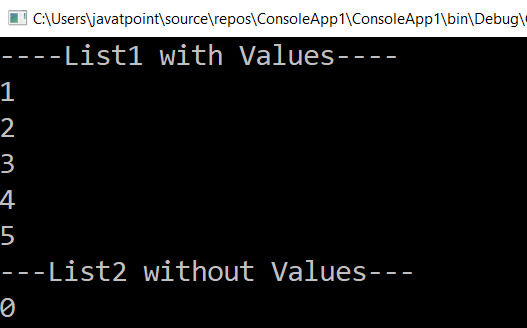在 LINQ 中,如果列表/集合包含空值或空值,则 DefaultfEmpty() 方法用于在这种情况下返回默认值;否则,它将从集合中的序列中返回元素。
当列表返回空值或空值时,使用 LINQ DefaultfEmpty() 方法获取元素列表的语法。
var result = List1.DefaultIfEmpty();根据上述语法,我们使用 LINQ DefaultfEmpty 方法获取项目列表。
LINQ DefaultfEmpty() 方法示例
这是 LINQ DefaultfEmpty() 方法的示例,用于在我们在列表/集合中未找到任何元素时从列表中获取元素或返回值。
using System;
using System. Collections;
using System.Collections.Generic;
using System. Linq;
using System. Text;
using System.Threading.Tasks;
namespace ConsoleApp1
{
class Programme2
{
static void Main(string[] args)
{
//create an array 'b'
int[] b = { };
int[] a = { 1, 2, 3, 4, 5 };
//with the help of DefaultfEmpty try to fetch the value from both of the list
var result = a.DefaultIfEmpty();
var result1 = b.DefaultIfEmpty();
Console.WriteLine("----List1 with Values----");
//with the help of foreach loop we will print the value of 'result' variable
foreach (var val1 in result)
{
Console.WriteLine(val1);
}
Console.WriteLine("---List2 without Values---");
//with the help of foreach loop we will print the value of 'result1' variable
foreach (var val2 in result1)
{
Console.WriteLine(val2);
}
Console.ReadLine();
}
}
}在上面的例子中,我们有两个列表 a 和 b,我们正在尝试使用 LINQ DefaultfEmpty() 方法从这两个列表中获取元素。
输出:

相关用法
- LINQ AsEnumrable()用法及代码示例
- LINQ ToLookup()用法及代码示例
- LINQ ElementAtOrDefault()用法及代码示例
- LINQ Count()用法及代码示例
- LINQ Single()用法及代码示例
- LINQ sum()用法及代码示例
- LINQ ToArray()用法及代码示例
- LINQ Min()用法及代码示例
- LINQ ToDictionary()用法及代码示例
- LINQ LastOrDefault()用法及代码示例
- LINQ FirstOrDefault()用法及代码示例
- LINQ GroupBy()用法及代码示例
- LINQ Cast()用法及代码示例
- LINQ ToList()用法及代码示例
- LINQ Max()用法及代码示例
- LINQ Aggregate()用法及代码示例
- LINQ Last()用法及代码示例
- LINQ ElementAt()用法及代码示例
- LINQ OfType()用法及代码示例
- Lodash _.sampleSize()用法及代码示例
注:本文由纯净天空筛选整理自 LINQ DefaultfEmpty() Method。非经特殊声明,原始代码版权归原作者所有,本译文未经允许或授权,请勿转载或复制。
